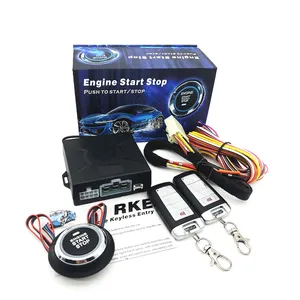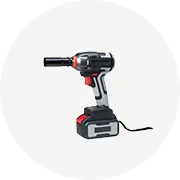Types of Keyless Start Kits
A keyless start kit is an electronic ignition system that replaces the traditional mechanical ignition switch. With this system, a driver does not need to physically interact with the ignition switch to start or stop the vehicle. As long as the key fob is inside the car, the driver can start and stop the engine with a push of a button. This system enhances security, convenience, and vehicle design flexibility.
Passive Keyless Entry Systems
These systems automatically detect the key fob when it's within a certain range (typically 1-5 feet) of the vehicle. When detection occurs, the system unlocks the doors and enables other functions:
- No physical button pressing required on the key fob
- Automatic door unlocking when approaching with the fob
- Some systems include automatic trunk access
- Enhanced convenience as the fob can remain in pocket or bag
Best for: Users prioritizing convenience and hands-free operation
Active Keyless Entry Systems
These systems require user interaction by pressing a button on the key fob to unlock or access the vehicle:
- Commonly used in trucks and vehicles with manual door locks
- Can be programmed to unlock only the driver's door initially
- Provides more control over the unlocking process
- Better security through deliberate activation
Best for: Vehicles requiring extra security measures and controlled access
Expert Tip: When choosing between passive and active systems, consider your daily routine. If you often approach your vehicle with hands full (shopping, children, etc.), a passive system offers significant convenience. For maximum security in high-risk areas, an active system gives you more control over entry points.
| Feature | Passive Systems | Active Systems |
|---|---|---|
| User Interaction | Minimal (proximity-based) | Required (button press) |
| Range | 1-5 feet typically | Up to 30-50 feet |
| Security Level | Good | Very Good |
| Convenience | Excellent | Good |
| Battery Life | Shorter (constant signal monitoring) | Longer (only active when pressed) |
Specifications and Maintenance of Keyless Start Kits
Keyless ignition systems offer convenience and safety for modern car owners. With key fobs and push buttons, these systems allow drivers to start and stop their engines without traditional keys. Understanding the specifications and maintaining keyless start kits is crucial for their optimal performance.
Key Components and Specifications
Key Fob
- Contains transmitter and battery
- Includes emergency backup key
- Features rolling code or encrypted signal technology
- Transmission range: 1-50 feet (depending on type)
- Battery life: 1-3 years under normal use
Receiver Module
- Located inside the vehicle
- Communicates with key fob via radio frequency
- Connects to the body control unit (BCU)
- Includes anti-collision technology
- Features signal amplification capabilities
Push-Button Switch
- Illuminated for visibility
- Connected to BCU and ignition system
- Typically requires brake/clutch depression for activation
- Designed for hundreds of thousands of activations
- Often includes status indicator light
Ignition Control Module
- Links push-button to engine control system
- Performs safety checks before startup
- Communicates with engine control module (ECM)
- Controls starting and stopping sequences
- Monitors system readiness conditions
Maintenance Requirements
| Maintenance Task | Frequency | Importance | Notes |
|---|---|---|---|
| Key Fob Battery Replacement | Every 1-3 years | High | Low battery can prevent startup or reduce range |
| Key Fob Cleaning | Monthly | Medium | Use soft, damp cloth; avoid harsh chemicals |
| Connection Inspection | Annually | High | Check for loose or corroded connections |
| Vehicle Battery Maintenance | Quarterly | High | Weak battery affects keyless system performance |
| Professional System Inspection | Annually | Medium | Diagnose issues and update if necessary |
Maintenance Tip: Store your spare key fob in a metal container or signal-blocking pouch when not in use. This prevents battery drain and protects against potential relay attacks that criminals might use to intercept your key's signal.
How to Choose Keyless Start Kits
With numerous keyless start systems available on the market, selecting the most appropriate one requires careful consideration of several key factors. Whether you're a retailer looking to stock inventory or an individual seeking the right system for your vehicle, these selection criteria will help guide your decision:
Security Features
When evaluating keyless start systems, security should be your primary concern:
- Look for systems with RFL (Radio Frequency Lock) blocking technology
- Select options with encrypted transmission between fob and receiver
- Consider models with rolling code technology that changes authentication codes
- Verify if the system includes tamper alerts or immobilizer features
- Check for emergency override capabilities in case of system failure
Priority level: Critical - This should be your first consideration
Vehicle Compatibility
Not all keyless systems work with every vehicle model:
- Verify compatibility with specific make, model, and year
- Check for CAN-bus integration capabilities
- Consider OEM versus aftermarket options
- Assess if hardware modifications are required
- Look for universal systems with broad compatibility ranges
Priority level: Critical - An incompatible system is useless
Installation Complexity
The ease of installation can significantly impact user satisfaction:
- Evaluate if DIY installation is realistic
- Check for plug-and-play options versus those requiring wiring
- Look for detailed installation instructions and support
- Consider if professional installation is recommended
- Assess tools and technical knowledge required
Priority level: High - Impacts total cost and customer satisfaction
Price and Value
Balance cost considerations against features and quality:
- Compare price points across similar systems
- Consider the warranty length and coverage
- Evaluate included accessories and extras
- Factor in potential installation costs
- Assess long-term reliability versus initial savings
Priority level: High - Must align with target market's budget
Buying Tip: When selecting keyless start systems for resale, consider offering tiered options (basic, standard, premium) to accommodate different customer needs and budgets. Include value-added services like installation guides, troubleshooting support, or extended warranties to differentiate your offerings in a competitive market.
Quality Indicators
How to identify high-quality keyless start systems:
| Quality Factor | What to Look For | Warning Signs |
|---|---|---|
| Manufacturing Standards | CE/FCC certification, ISO compliance | Missing certifications, generic packaging |
| Material Quality | Durable plastics, quality connectors | Flimsy construction, loose components |
| Supplier Reputation | Established brand, positive reviews | Unknown manufacturer, limited history |
| Support Documentation | Detailed manuals, online resources | Poor translations, minimal instructions |
| Warranty Coverage | 1+ year warranty with clear terms | No warranty or complicated claim process |
How to DIY and Replace Keyless Start Kit
Installing a keyless car start system is a rewarding DIY project that can significantly enhance your vehicle's convenience and modern feel. With proper preparation and careful execution, most moderately skilled DIY enthusiasts can complete this installation successfully.
Safety Warning: Always disconnect the vehicle's battery before beginning any electrical work to prevent short circuits and potential damage to your vehicle's systems. If you're unsure about any step, consult a professional installer.
Required Tools and Components
| Essential Components | Required Tools | Optional Tools |
|---|---|---|
| Key fob | Screwdrivers (Phillips and flathead) | Multimeter |
| Ignition switch | Socket set with various sizes | Electrical tape |
| Wiring harness | Wire strippers/crimpers | Cable ties |
| Control module | Trim removal tools | Soldering iron and solder |
| Antenna | Electrical tape | Heat shrink tubing |
| Push-button start | Utility knife | Digital camera (for reference photos) |
Installation Process
-
Disconnect the Battery
For safety, locate your vehicle's battery and disconnect the negative (black) terminal first, then the positive (red) terminal. This prevents short circuits during installation.
-
Remove Ignition Switch
Consult your vehicle's service manual for specific instructions. Typically, this involves removing steering column covers and unscrewing the ignition switch assembly. Take photos before disassembly for reference.
-
Connect Wiring Harness
Following the manufacturer's instructions, connect the new wiring harness to your vehicle's ignition system. Match wire colors carefully and use crimp connectors or solder connections for reliability.
-
Install Control Module
Find a suitable mounting location for the control module, typically under the dashboard away from moving parts and excessive heat. Secure it with screws, brackets, or strong adhesive tape.
-
Install Antenna
Position the antenna near the control module but away from metal objects that could block signals. Route the antenna wire to optimize reception without creating interference with other systems.
-
Connect Power and Ground
Connect the control module to the vehicle's power supply and establish a solid ground connection. Ensure power connections are properly fused for protection.
-
Program Key Fob
Follow the manufacturer's precise programming sequence to sync the key fob with the control module. This typically involves a specific button sequence and timing.
-
Test the System
Before final reassembly, temporarily reconnect the battery and test all functions of the keyless start system, including door locks, trunk release, and engine start/stop.
-
Reassemble and Secure
Once verified working, disconnect the battery again, secure all components, bundle loose wires with cable ties, and reinstall any removed panels or covers.
-
Reconnect the Battery
Reconnect the positive terminal first, then the negative terminal. Ensure connections are clean and tight.
-
Final Testing
Perform a comprehensive test of all vehicle systems to ensure the installation hasn't affected other functions and that the keyless start system works reliably.
Installation Tip: Take photos at each step of disassembly and make notes about wire connections. This documentation will be invaluable if you encounter issues or need to troubleshoot later. Consider testing critical electrical functions after each major connection to isolate potential problems early in the installation process.
Frequently Asked Questions
Keyless entry allows access to the car without using a traditional key. The system either responds to a button press on the fob or automatically detects the fob's proximity to unlock doors. Keyless start (or push-button start) specifically refers to the engine ignition system that allows starting the vehicle without inserting a key into an ignition switch. Most modern systems combine both features, but they serve distinct functions - one for access and one for engine operation.
A properly installed keyless start system offers comparable security to traditional keys, with some potential advantages and disadvantages. Modern systems use encrypted signals between the fob and vehicle to prevent unauthorized access. However, sophisticated criminals have developed "relay attack" methods that can amplify and relay signals from key fobs inside homes to unlock and start vehicles. To enhance security, consider:
- Using a signal-blocking pouch for your key fob when not in use
- Installing additional physical security measures like steering wheel locks
- Choosing systems with advanced encryption and anti-theft features
- Parking in secure, well-lit areas whenever possible
Not all vehicles can accommodate aftermarket keyless start systems. Compatibility depends on several factors:
- Vehicle Age: Modern vehicles (generally post-2000) with electronic ignition systems are better candidates
- Electrical System: Vehicles with simple, mechanical ignition systems may require extensive modification
- Computer Systems: Cars with sophisticated engine management systems may reject aftermarket modifications
- Physical Space: Some vehicles lack adequate space for installing control modules and buttons
Always consult with a professional installer or check manufacturer compatibility lists before purchasing a system for your specific vehicle make, model, and year.
Installing an aftermarket keyless start system could potentially affect your vehicle's warranty, but with important qualifications:
- Under the Magnuson-Moss Warranty Act (in the U.S.), manufacturers cannot void your entire warranty simply because you've installed aftermarket parts
- However, if the aftermarket installation directly causes damage, the manufacturer can deny warranty coverage for those specific components
- Professional installation by certified technicians minimizes the risk of installation-related problems
- Some premium aftermarket systems offer their own warranty to cover potential issues
For vehicles under warranty, consider using dealer-approved accessories or consulting with your dealer before installation.
Yes, keyless start systems are available for various types of vehicles beyond cars, including:
- Motorcycles: Specialized keyless systems are designed for motorcycle ignition systems, often with anti-theft features
- ATVs & UTVs: Off-road vehicles can benefit from keyless systems that resist dirt and moisture
- Boats: Marine-grade systems are available with waterproof components
- RVs: Systems for recreational vehicles often include multiple zone controls
When purchasing for non-automotive applications, ensure you select a system specifically designed for your vehicle type, as ignition systems vary significantly across different vehicle categories. Look for systems with appropriate weather resistance and durability ratings for the intended application.




























































































































































































































































 浙公网安备 33010002000092号
浙公网安备 33010002000092号 浙B2-20120091-4
浙B2-20120091-4